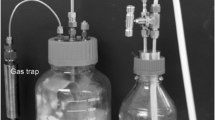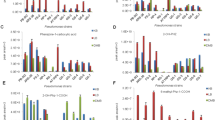Summary
In shaken cultures, a strain of Pseudomonas cepacia isolated from apple leaves produced pyrrolnitrin and four other phenylpyrrole antibiotics. The concentrations of these metabolites were determined at intervals for 7 days in three different media at two initial pH levels. Optical density measurements revealed maximum cell concentrations after 24 h in nutrient broth, after 48 h in King's B medium, and after 96 h in minimum salts solution. The effects caused by initiating fermentations at pH 5.8 rather than 7.0 were in most cases not dramatic, although in some instances, especially in minimum salts broth, higher concentrations of metabolites were produced with the lower initial pH. Concentrations of the phenylpyrrole antibiotics were greatly affected by choice of culture medium and incubation time. Concentrations of the two nitrophenyl metabolites, pyrrolnitrin and 2-chloropyrrolnitrin, rose throughout the 7-day incubation and were more than 20 times greater in minimum salts medium than in either King's B medium or nutrient broth. The maximum concentrations of each of the three aminophenyl metabolites (dichloroamino, trichloroamino and monochloroamino) occurred in different media, the monochloro compound in nutrient broth, the dichloro compound in Kings B medium and the trichloro compound in minimum salts medium. The time dependence of the concentrations of the five metabolites supports the proposed biosynthesis of these pyrroles from tryptophan by successive chlorinations followed by oxidation of the amino group at the end of the pathway.
Similar content being viewed by others
References
Arima K, Imanaki H, Kousaka M, Fukuta A, Tamura G (1964) Pyrrolnitrin, a new antibiotic substance, produced by Psneudomonas. Agric Biol Chem 28:575–576
Arima K, Imanaki H, Kousaka M, Fukuda A, Tamura G (1965) Studies on pyrrolnitrin a new antibiotic. I. Isolation and properties of pyrrolnitrin. J Antibiot A18:201–204
Chang CJ, Floss HG, Hook DJ, Mabe JA, Manni PE, Martin LL, Schröder K, Shieh TL (1981) The biosynthesis of the antibiotic pyrrolnitrin by Pseudomonas aureofaciens. J Antibiot 34:555–566
Elander R, Mabe J, Hamill R, Gorman M (1968) Metabolism of tryptophans by Pseudomonas aureofaciens VI. Production of pyrrolnitrin by selected Pseudomonas species. Appl Microbiol 1968:753–758
Floss HG, Manni PE, Hamill RL, Mabe JA (1971) Further studies on the biosynthesis of pyrrolnitrin from tryptophan by Pseudomonas. Biochem Biophys Res Commun 45:781–787
Hamill R, Elander R, Mabe J, Gorman M (1967) Metabolism of tryptophans by Pseudomonas aureofaciens V. Conversion of tryptophan to pyrrolnitrin. Antimicrob Agents Chemother 1967:388–396
Hamill R, Elander R, Mabe J, Gorman M (1970) Metabolism of tryptophans by Pseudomonas aureofaciens III. Production of substituted pyrrolnitrins from tryptophan analogs. Appl Microbiol 19:721–725
Imanaka H, Kousaka M, Tamura G, Arima K (1965a) Studies on pyrrolnitrin, a new antibiotic. II Taxonomic studies on pyrrolnitrin-producing strain. J Antibiot A18:205–206
Imanaka H, Kousaka M, Tamura G, Arima K (1965b) Studies on pyrrolnitrin, a new antibiotic. III Structure of pyrrolnitrin. J Antibiot A18:207–210
Janisiewicz WJ, Roitman JN (1987) Postharvest Mucor rot control on apples with Pseudomonas cepacia. Phytopathology 77:1776
Janisiewicz WJ, Roitman JN (1988) Biological control of blue mold and gray mold on apple and pear with Pseudomonas cepacia. Phytopathology 78:1697–1700
Lively DH, Gorman M, Haney ME, Mabe JA (1966) Metabolism of tryptophans by Pseudomonas auerofaciens I. Biosynthesis of pyrrolnitrin. Antimicrob Agents Chemother 1966:462–469
Mahoney NE, Roitman JN (1990) High-performance liquid chromatographic separation of phenylpyrroles produced by Pseudomonas cepacia. J Chromatogr 508:247–251
Pee K-H van, Salcher O, Lingens F (1980) Formation of pyrrolnitrin and 3-(2-amino-3-chlorophenyl)-pyrrole from 7-chlorotryptophan. Angew Chem Int Ed Engl 19:828–829
Roitman JN, Mahoney NE, Janisiewicz WJ, Benson M (1990) A new chlorinated phenylpyrrole antibiotic produced by the antifungal bacterium Pseudomonas cepacia. J Agric Food Chem 38:538–541
Author information
Authors and Affiliations
Rights and permissions
About this article
Cite this article
Roitman, J.N., Mahoney, N.E. & Janisiewicz, W.J. Production and composition of phenylpyrrole metabolites prodcued by Pseudomonas cepacia . Appl Microbiol Biotechnol 34, 381–386 (1990). https://doi.org/10.1007/BF00170064
Received:
Accepted:
Issue Date:
DOI: https://doi.org/10.1007/BF00170064




